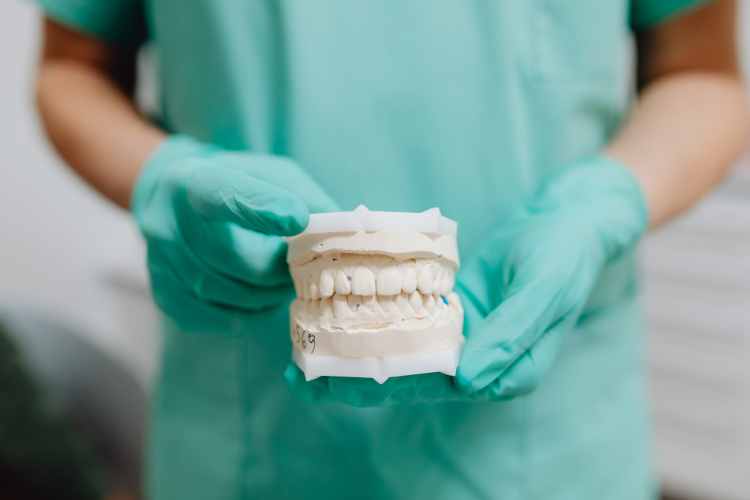A denture is a prosthetic tooth replacement made of a detachable piece or frame. For those over the age of 65 who are lacking several teeth, cast partial dentures are an option. The patient can have these molars taken out and restored.
Traditional partial dentures have several benefits over removable partial dentures with cast metal frames. These dentures have frames that are manufactured specifically to fit the teeth. They are extremely stable and retentive because they sit on and are connected to the teeth.
Continue reading to learn more about cast partial dentures, their fabrication, benefits, and drawbacks.
What exactly is Cast Partial Denture (CPD)?
CPDs (cast partial dentures) are removable dental prostheses used to replace one or more missing teeth. They are made of a metal framework that fits into the mouth and is surrounded by a plastic base and artificial teeth. The metal structure is typically composed of a cobalt-chromium or nickel-chromium alloy.
Here are some essential facts about cast partial dentures:
Fabrication: A dental laboratory creates cast partial dentures from an impression of the patient’s mouth. The metal framework is made using a technique known as lost-wax casting, in which a wax pattern is first created and then cast into the metal alloy.
Retention: Clasps that fit around the remaining natural teeth hold cast partial dentures in place. The clasps are made of the same metal as the framework and are designed to keep the teeth in place without damaging them.
Adjustment: If necessary, cast partial dentures can be adjusted or modified to improve fit or function. This is accomplished by removing or adding material from the plastic base or metal framework.
Maintenance: To remove plaque and food particles, cast partial dentures should be cleaned daily with a soft-bristled brush and denture cleaner. To prevent bacterial growth, they should also be removed at night and soaked in water or denture solution.
Durability:Cast partial dentures are more durable and last longer than other types of removable dentures. They can last for many years if properly cared for and maintained.
Cost: Due to the cost of materials and fabrication, cast partial dentures are typically more expensive than other types of removable dentures.
Comfort: It may take some time to get used to cast partial dentures, and they may cause some soreness or discomfort at first. However, most people find them to be comfortable and useful over time.
Overall, cast partial dentures are a dependable and efficient way to replace missing teeth. Your dentist can advise you on whether they are the best option for your specific dental needs.
The Benefits of a Cast Partial Denture
Cast partial dentures have several advantages that make them a common option for tooth replacement. Here are some of the primary advantages of cast partial dentures:
- Improved aesthetics: By replacing lost teeth and reinstating the natural form and contour of your mouth, cast partial dentures can improve the look of your grin.
- Improved speech: Missing teeth can make it difficult to talk effectively, but cast partial dentures can help recover your speech by supporting your tongue and lips.
- Improved biting ability: Missing teeth can make chewing and eating certain foods challenging, but cast partial dentures can help recover your ability to consume a wide range of foods.
- Prevents remaining teeth from shifting: When a tooth is lost, the remaining teeth may shift out of place, causing bite difficulties and other dental issues. By filling in the space and providing support for the remaining teeth, cast partial dentures help to avoid this.
- Increased comfort: Cast partial dentures are custom-made to suit your mouth, which can improve your comfort and reduce the risk of irritation or discomfort.
- Durable and long-lasting: Cast partial dentures are constructed of high-quality materials and are intended to last for many years with appropriate care and maintenance.
- Versatility: Cast partial dentures can be used to substitute one or more missing teeth and can be customised to your specific requirements and tastes.
Disadvantages of Cast Partial Denture
- A cast partial denture is hefty and cumbersome for the patient due to the use of a cast metal structure.
- It is hard to repair.
- It is delicate.
- The fabrication process is complicated.
- It necessitates more dentist appointments and takes longer to create.
- Expensive
- Inability to protect against detrimental lateral loads.
- It necessitates regular maintenance.
- Aesthetically, it’s not appealing.
Each therapy technique has its own set of advantages and disadvantages. As a result, it is crucial to confer with your dentist in order to select the best treatment choice for you.
In terms of performance, natural teeth are always superior to artificial teeth. As a result, it is critical to practise excellent oral care on a frequent basis to prevent tooth loss in the first place. Daily tooth brushing, flossing, mouthwash, tongue cleaning, and regular dental appointments can all aid in the maintenance of good oral health. Remember that good dental health can lead to better overall health.

